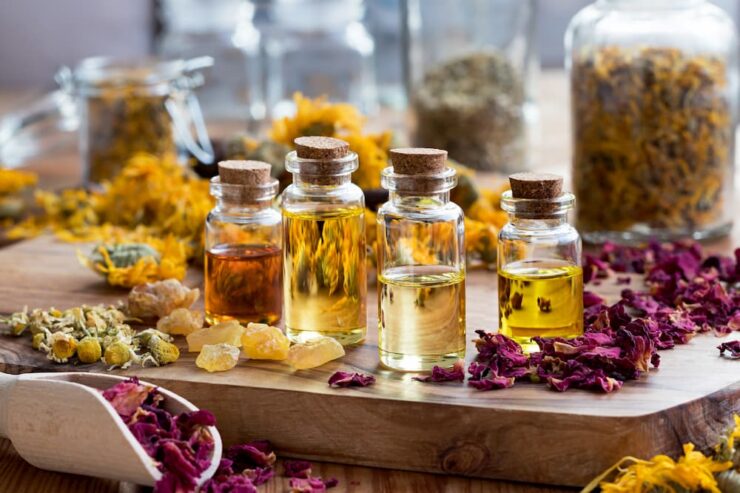In the world of senses, scent is perhaps the most evocative. A whiff of a certain perfume can transport us back to our childhood, remind us of a cherished loved one, or spark an intense emotional response. But have you ever wondered what lies behind these potent fragrances that so deeply touch our lives? It’s the subtle, yet profound science of chemistry. The olfactory delights we indulge in are, in essence, a symphony of chemical reactions, a tango of molecules dancing with our sensory perceptions. This blog post aims to explore the fascinating chemistry of perfumes and understand how they interact with our senses, thereby forming what we call the ‘fragrance connection’.
The Basics of Perfume Chemistry
The art of perfumery hinges on a sophisticated understanding of chemistry. A typical perfume consists of three distinct layers of scents, known as top, middle, and base notes. The top notes provide the initial, ephemeral fragrance that you smell upon application, followed by the more robust middle notes, and finally the enduring base notes that linger the longest. If you want top quality in each department you’ll go with Creme de Cuir.
Perfumes are composed of three fundamental elements: essential oils, solvents, and fixatives. Essential oils are the heart of any perfume, providing the scent. Solvents are used to dissolve these oils, while fixatives are employed to prolong the fragrance’s longevity. These components harmoniously interact to create the unique, multi-layered characteristic of a perfume.
Understanding Essential Oils

The soul of any perfume lies in its essential oils. These are volatile substances extracted from natural sources such as flowers, fruits, and woods. Each essential oil brings its unique scent profile, contributing to the top, middle, or base notes of a perfume. For instance, citrus oils like orange and lemon offer fresh top notes, floral oils such as rose and jasmine serve as romantic middle notes or romantic fragrances, and woody oils like sandalwood or musk often form the sensual base notes. These essential oils significantly influence the overall fragrance profile, acting as the starring characters in our olfactory play.
The Role of Solvents
Imagine having a beautiful color palette but no canvas to paint on. That’s where solvents come in for perfumery. Solvents are used to dissolve essential oils, creating a medium that can be easily applied to the skin or clothing. Common solvents include alcohol and water. The choice of solvent plays a significant role in determining the perfume’s volatility (how quickly it evaporates) and longevity. Just as a skilled artist selects the perfect canvas for their masterpiece, a master perfumer must choose the right solvent for their fragrance.
Fixatives: Making the Scent Last
Have you ever wondered why certain perfumes last longer than others? That’s the work of fixatives. These are substances used in perfumery to slow down the evaporation of the volatile aromatic components, thereby prolonging the fragrance’s lifespan. Fixatives can be of natural origin, like musk, or synthetic, such as synthetic ambers. They form a crucial part of the perfume’s composition, acting as a backdrop that allows the essential oils to shine, while also stabilizing the perfume’s overall scent.
The Science of Perfume Notes

As touched upon earlier, a perfume consists of top, middle, and base notes. But what is the chemistry behind these notes? It all boils down to the molecular structure of the components and their volatility. Top notes consist of small, light molecules that evaporate quickly, delivering the first impression of the perfume. Middle notes make up the perfume’s heart, evaporating more slowly and forming the main body of the fragrance. Base notes, with their larger, heavier molecules, evaporate the slowest, providing depth and solidity to the perfume. This ordered release of notes creates the perfume’s evolving scent narrative, akin to a musical composition unfolding over time.
The Art of Perfume Blending
The alchemy of perfume creation is in blending different essential oils to create unique, harmonious fragrance combinations. Just like a musician composes a melody by combining different notes, a perfumer creates a scent by balancing various aromatic compounds. This blending process is where the mastery of chemistry meets the creativity of art. Perfumers use their knowledge of the volatility and interactivity of different components to build a multi-layered, complex olfactory experience.
The Impact of pH on Perfumes
Another fascinating aspect of perfume chemistry is the impact of pH levels. Just like any other chemical solution, the pH can significantly influence a perfume’s scent and its interaction with the skin. High pH can cause fragrances to become more acidic and sharp, while low pH can make them smell softer and sweeter. Therefore, pH testing is a crucial step in perfume development and manufacturing. Moreover, individual skin chemistry can also alter the perception of a perfume’s scent, making it a highly personal experience.
Synthetic vs. Natural Fragrances

When it comes to perfumes, a significant debate exists over natural vs. synthetic fragrances. Natural fragrances, derived from plants and animals, are complex mixtures of hundreds of chemical compounds, imbuing the perfume with a depth and richness hard to replicate synthetically. However, they can be expensive, difficult to extract, and pose sustainability concerns.
On the other hand, synthetic fragrances, created in laboratories, offer consistency, are cost-effective, and can replicate or create scents not found in nature. But they can also be associated with allergic reactions and lack the complexity of natural fragrances. Both types have their pros and cons, making it a matter of personal preference and industry ethics.
How Perfumes Evoke Emotions and Memories
Science explains our emotional response to fragrances through the connection between our olfactory system and the limbic system, the emotional center of the brain. When we smell a fragrance, the olfactory nerves send signals directly to the limbic system, triggering emotional responses and memories associated with that scent. This complex neural interaction makes fragrances a powerful tool for evoking emotions and nostalgia.
Perfume Chemistry and Personal Preferences

Our preferences for certain scents are shaped by a complex interplay of genetic, cultural, and psychological factors. Genetics play a role in determining our olfactory receptors, thus influencing what scents we can perceive and how we perceive them. Cultural factors, such as exposure to certain scents during childhood, can shape our scent preferences. Psychological factors, like the association of scents with certain emotions or experiences, also play a significant role. Understanding this can help us comprehend why we’re drawn to certain scents over others, reinforcing the intricate relationship between perfume chemistry and personal preferences.
Conclusion
The world of perfumes is a beautiful interplay of chemistry, emotions, and memories. The carefully balanced concoctions of essential oils, solvents, and fixatives that make up our favorite fragrances are not just chemicals in a bottle; they’re olfactory experiences, emotional triggers, and memory catalysts. As we’ve explored in this blog post, the chemistry of perfume is a complex, fascinating subject, and understanding it can not only enhance our appreciation of these olfactory delights but also help us make more informed choices when selecting our ideal perfume.

